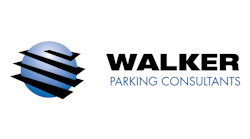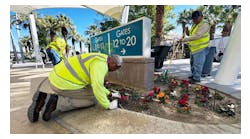For most airports, parking is one of their most valuable assets. In addition to being an important source of revenue, airport parking facilities are also essential to the airport’s smooth operation because travelers count on being able to quickly find a parking space near their terminal so they can get to their flights. By providing efficient, user-friendly parking, airports can help assure a smooth transition for travelers from their vehicles to their planes.
The importance of parking as a source of revenue can’t be overstated. In fact, it is generally the largest source of non-airline income for U.S. airports. Parking revenue is so crucial to the ongoing financial well-being of airports that many rely on it to pay for the lion’s share of enhancements and upgrades to services and equipment not associated with parking. Parking revenues are commonly used to help fund terminal improvements, roadway and other infrastructure enhancements, staffing, and even marketing efforts.
As important as parking is to airport operations, it’s surprising how often airport administrators treat it as an afterthought. Many airports take a “build it and forget it” approach to their parking assets. After building new structures, airports administrators often operate them with minimal maintenance, repairing things that wear out or break down, but otherwise paying little attention to maintaining their parking facilities. The problem with this approach is that inadequate (or, often, non-existent) maintenance typically causes parking facilities to require major repairs well before the expected life of the garage, with critical systems, technology, and infrastructure breaking down prematurely. These unnecessary break-downs often require unplanned repairs that can significantly impact operations and revenue. All too often, airports are forced to renovate or replace unmaintained structures much earlier than planned—and much sooner than capital planning will allow.
Today, however, some airports are pursuing a more proactive approach, entering into five-year on-call relationships with parking maintenance and restoration experts to minimize wear and tear within the structure, minimize repair costs, and put off its eventual replacement. In addition to typical maintenance functions such as concrete restoration and equipment repair, these five-year engagements also typically include upgrades designed to minimize deterioration of the facility and equipment breakdowns. The idea isn’t just to fix things when they go wrong, but to prevent things from going wrong in the first place. It also provides an opportunity to develop and maintain a “wish list” for parking improvements, including lighting upgrades through which existing lights are replaced with energy efficient LED lighting systems; painting ceilings to improve visibility, and improve the overall atmosphere within the structure; operational changes, including adapting driving aisles and pedestrian areas; and introducing new technologies and parking products to improve customer service and enhance operations.
In addition to extending the useful life of parking structures, this proactive approach also improves the day-to-day parking experience for travelers. And when maintenance or repairs are necessary, this more strategic approach typically allows the structure to remain operational when the work is being done.
Getting Started
So, how does a five year maintenance and restoration program work? When the program commences, the first step is to evaluate the current performance of parking areas. There are two areas of primary concern to be evaluated: customer service and operations. In evaluating customer service, airport managers and their operators need to determine whether parking facilities are pleasant, intuitive, and convenient for drivers. This largely revolves around determining how easy it is for parkers to find a space close to their gate or other destination, and whether drivers can enter and exit the facility quickly and conveniently. The process begins with an internal inventory. Are stairways and floors clean and well-illuminated? Is access and revenue control equipment in good working order? Are exits and entrances congested? Do parkers have to circle parking areas to find an open space? What is the condition of the existing structure?
On the operational side, the 5 year program should begin with an equipment and systems audit to assure that facilities are operating at optimum efficiency and that equipment is up-to-date and operating well. This also requires an inventory. Is access and payment equipment working properly? Is facility management equipment and its software up-to-date? Are you charging the right rates? Is technology being used to cost effectively control costs? If your facility accepts credit cards for parking payments, is it compliant with Payment Card Industry Data Security Standards (PCI-DSS)?
Improving Parking
The answers to the questions posed through the inventories will determine what remedies are required, and permit parking consultants and airport administrators to create long-term schedules for maintaining and improving facilities and equipment. If stairwells and floors aren’t sufficiently clean and illuminated, the fix may be as simple as washing parking areas and installing high-efficiency LED lighting. Likewise, if congestion is found at entrances and exits, the solution may be to fully automate payment and access control through pay-on-foot and card in/card out technologies. In addition to enhancing customer service, these technologies also significantly reduce the risk of theft.
If parkers find it difficult and time-consuming to find parking, the answer could be found in a parking guidance system. There are several different guidance systems, from LED signs outside entrances indicating how many spaces are available and on what floors, to complex systems featuring illuminated single space sensors that show parkers where open spaces can be found through a series of green and red lights. Parking guidance has become increasingly important at airports because of the many benefits they offer both airports and travelers. The advantages for travelers are obvious: by guiding parkers directly to available parking that’s close to their gates, sensor-based systems eliminate the frustration of searching for parking and make it easier for travelers to make their flights on time. At the same time, when cars aren’t fruitlessly circling driving aisles looking for a space, they aren’t causing as much wear and tear on the garage itself. This can provide significant maintenance and repair savings, and delay having to replacement the facility. It also reduces emissions with less search and idling time. Finally, parking guidance systems can enhance revenues by helping the garage achieve full occupancy because drivers are less likely to give up a search for a spot and leave the facility.
Modern mobile and net-based technologies are also available through which parkers can use apps on their smartphones to find open parking. Systems can also be launched allowing travelers to use smart phones and computers to reserve a space or arrange for valet parking. Some airports even offer frequent flyer or similar award programs that provide special discounts or parking privileges, and which can be accessed by travelers with their smart phones. These are amenities that can give airport parking facilities an important competitive edge over satellite lots, and they are often instituted as part of a 5 year parking plan to address shortcomings or competitive challenges discovered through the initial inventory process.
Simple fixes are also available for administrative shortcomings. The 5 year plan should include regular evaluation of all management software that’s being used in parking facilities. When software becomes obsolete or stops meeting all of garage’s unique needs, the easy solution is to purchase a management software package that meets all of those needs. And if equipment isn’t operating to full capacity, it should be repaired or replaced.
One final, and extremely common way, that parking facilities struggle is through pricing. It is essential for airports to charge enough to meet operational requirements and generate revenue, but at the same time it’s important not to charge too much and drive travelers to competing lots. It can be challenging to figure out whether parking rates are too high, too low, or just right. That’s why an operations analysis is an essential part of any 5 year plan. Throughout the 5 year program utilization (how close to capacity the facility is from day-to-day) can be studied and the consultant can make recommendations if pricing adjustments are called for. Airport administrators may feel great about the fact that their parking facilities are full every day, but this may actually be a warning sign that they aren’t charging enough! When this is the case, owners are leaving money on the table. Likewise, if a facility tends to operate well under capacity every day, it may be an indication that rates are too high. Though it may also be because the facilities aren’t convenient, clean, or efficient enough. These are all questions that the consultant can answer throughout the life of the 5 year program.
Preparing for the Future
The third element of the five year plan is to prepare for the future. One essential item that’s often ignored by owners is preventive maintenance. Few types of buildings experience as much wear and tear and are as susceptible to the elements as parking. Just as new parking structures come with maintenance manuals providing guidance for protecting the facility through regularly-scheduled cleaning and other preventive maintenance, the five-year plan should also include a maintenance schedule.
And airport parking facilities need to remain operational when maintenance and repairs are being conducted. Except under the most extreme conditions, airports don’t close; their parking facilities need to be open whenever terminals are. When maintenance and repairs are scheduled throughout a 5 year program it is much easier to assure that parking facilities can stay open while the work is being completed.
Parking is vital, both for the revenues it provides airports and for the role it plays in meeting the needs of travelers. By implementing a five-year strategic parking plan, airport administrators can be sure that they are getting the most out of parking. And when the five-year plan is completed, it’s time to start again!
Todd Lohman is managing principal of Walker Parking Consultants’ Indianapolis office. He can be reached at [email protected].





